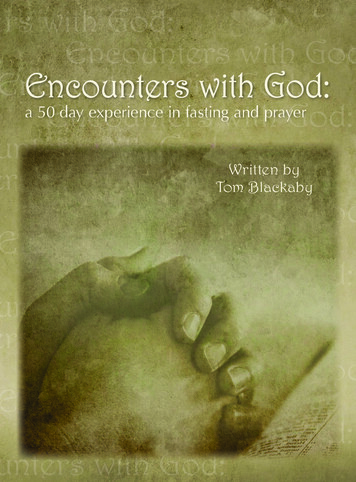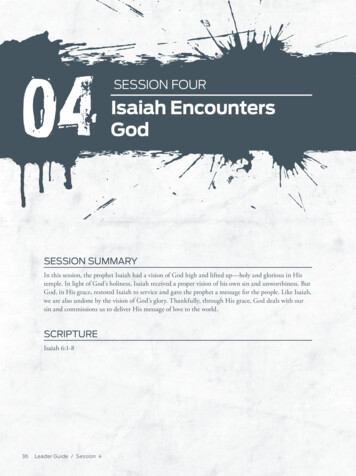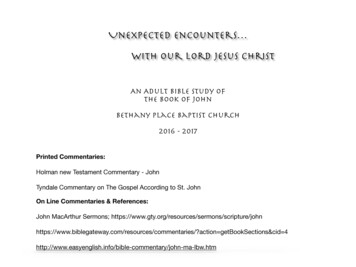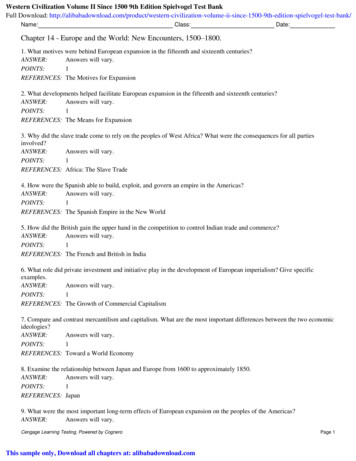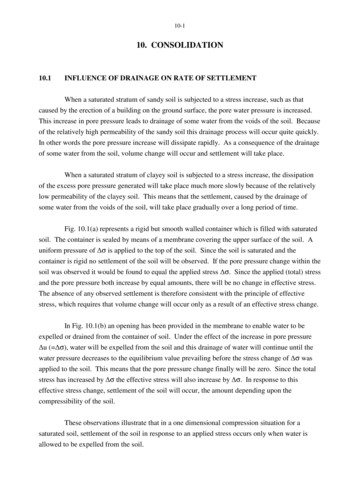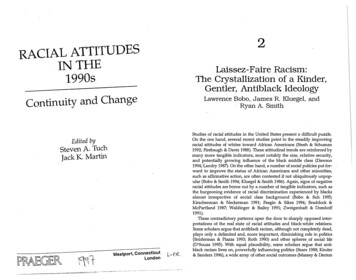
Transcription
Initial EncountersIn the Gospel of Signs
Some review Logos and the Divine Word ”And God said, ‘Let there be light’ ” Translation issues, e.g., 1:17: “Grace instead of grace” or “grace upongrace” or “grace responding to grace” Textual and Translation issues: e.g., 1:18: μονογενὴς θεός/υἱός “Unique (only begotten) one who is God” – 1:1; 20:28 “Unique (only begotten) Son” – 3:16
The Ministry (and “Book of”) of Signs Begins 1:19-51: Four days in Galilee John the Baptist and First Disciples Titles of Jesus 2:1-11: Wedding Feast, 1st Sign, of what? 2:12-25: Incident at the Temple Is it a “sign”?
An Organizing Principle: Diptychs 1:19-34: The Baptist – 1:35-51: The First Disciples Each with two internal diptychs 2:1-12: Cana – 2:13-22 The Temple Celebratory Sign vs Punishment and Prophecy? 3:1-21: Nicodemus (M) – 4:1-26: Samaritan Woman (F) Each with two appended diptychs: 3:22-30/3:31-36.– 4:27-38/4:39-45 Followed by an epilogue, Sign 2: 4:46-54 5:1-46: Healing – 6:1-71: Feeding A new overarching principle of order: Jewish feasts Internal dyad: Act and Discourse
Jesus and John: An Internal Diptych Day 1: 1:19-28: Citation of Isa 40:3 (Mk 1:2-3 adds Mal 3:1) John denies being Christ, Elijah or a prophet “Another is coming; I’m not worthy to untie his sandal” (Mk 1:7 parr) I baptize with water. Mk 1:8a. Day 2: 1:29-34: “Behold the Lamb who takes away sin” Testimony: “I saw the Spirit descending” Mk 1:10: Jesus saw; Mt 3:16: heavens opened; Lk 3:21-22: “bodily form, like dove” He will baptize with holy spirit. Mk 1:8b. Affirms and Entices John definitely inferior; Jesus endowed with the Spirit What kind of “lamb” is Jesus? Paschal? Sin offering?
Disciples: Another Diptych Day 3: 1:35-42: First disciples: ”Lamb” repeated Two disciples, Andrew, bro of Peter Anonymous Peter gets a name, “Cephas (Rock, Rocky), translated Peter” 1:38 A dialogue: “Where are you staying (Gk. meno)?” ”Come and see.” Curiosity can be productive. 39: They saw where he stayed and they stayed. Day 4: 1:43-51: Philip tells Nathanael, “Come and see.” 1:46: Flash of irony: What good comes from Nazareth? 1:48: Jesus shows special knowledge of “guileless” Nathanael. Cf. 2:25: Jesus knew what was in people. 1:49: Nathanael responds with a confession. 1:51: Jesus says, Just you wait and you’ll see angels on the Son of Man.
A Roster of Titles 1:34, 36: John, “Son of God,” “Lamb of God” 1:38: Two disciples: “Rabbi,” “translated Teacher” 1:41: Peter: “Messiah” “translated Christ” 1:42: Jesus: “You are Kephas,” “translated Peter” 1:45: Philip: “Of whom Moses, in the Law, and the Prophets wrote” 1:49: Nathanael: “Rabbi, Son of God, King of Israel” 1:51: Jesus: “Son of Man” Can be a way of saying “human being” (opp. To “son of beasts”) So Dan 7:13, a symbol of Israel, contrasted with “beastly” empires
1:51: The Son of Man: Synoptics A riddle, based on Dan 7:13 understood as prophecy not symbol (Mt 16:13):Who do people say he is? Mk: Who do people say I am? (Does SoM simply “I”?) Present: Mk 2:28 parr. “Lord of Sabbath”; Mt 8:20//Lk 9:58 “No place to lay his head” Suffering: Passion predictions Mk 8:31; 9:31; 10:33 parr. Coming (Dan 7:13): Mk 13:26: Eschatological prophecy: “coming on the clouds” Mk 14:62: Climax of trial scene: prediction of “clouds of heaven” Mt 25:31-46: The Son of Man in his Glory, w angels, judges sheep & goats.
In John Coming: 1:51: Jacob’s Ladder (Gen 28:12) But when will the “heavens be opened”. Language of revelation: Rev 4:1; 11:19 Suffering Lifted up: 3:13-14: Moses’ serpent (Num 21:8-9); But descended from heaven (v. 13) Lifted up “glorified” (Isa 52:13 LXX) Twice echoed 8:28; 12:23, like Mark’s 3 passion predictions Present: 5:27: Has life Power to judge. But does he use it? See 3:17 (no) vs 9:39 (yes)! 9:35: object of belief. Believe what you “see”, now. 13:31: “Glorification” is happening Now! Walk in his light. A Riddle: 12:34: Crowd, “Who is the Son of Man anyhow?” Does Pilate answer?: 19:5: “Ecce homo”: “Behold, the Man.” What happened to the Coming Judge?
A Wedding at Cana, A Sign
What’s a “Sign” Miraculous Deeds, as in “Signs and Wonders” Mk 8:11-12; Acts 2:9; 1 Cor 1:22; Heb 2:4 Do they authorize or signify something “Evidence,” 2:11; 2:23; 3:2; 6:2; 7:31; 9:16; 11:47; 20:30 But the FG resists: 4:48; 6:26, Simply “seeing” not enough. How does one “see” a sign, by observing it or probing its meaning?
How Do Actions Signify? In Many Ways Pointers to significance of Jesus As the one “sent from God” Active signs combine with verbal “signs” (light, shepherd, vine, etc.) Pointers to the past that Jesus embodies Sacred space (Temple); Time (Festivals) Pointers to the reality that his coming creates Baptism, Eucharist, Faith (How much Christian ritual is involved?)
What about Cana? Evidence or Symbol? Authorizing Jesus? Note the question at 2:18 at the Temple incident. People seek authorization. Is that what Jesus provides? Of old become new? An echo of Mt 9:17//Lk 5:37: “New wine old skins” The new ? Knowledge? Relationship? Ritual action? Of the sanctity of marriage? Contrast the saying on ”eunuchs” (Mt19:12) Or of its transformation? See Paul wrestling with marriage, 1 Cor 7. Of relationship to Jesus? Focus on his Mother Many possibilities; no definite answer
The Role of the Mother Jesus’ time “not yet” A story of youthful petulance? Calling her “Woman”? ( Madam) Are “Family” ties important? Is a new family created at the cross: Jn 19:26 Jesus answers prayer as he answered her? Assurances given at 14:13; 15:16; 16:23-26
Giotto Florence 1267-1337
Hieronymus Bosch Dutch 1450-1516
PaoloVeronese Venice 1528-1588
Konstantin Makovsky Russian 1839-1915
“Cleansing” the Temple
Familiar but distinctive Synoptic accounts Action: Matt 21:12-13 – Mark 11:15-17 – Luke 19:45-46 Saying 1: Isa 56:7 Jer 7:11: “house of prayer – den of thieves” Saying 2: Destroy/rebuild: Matt 26:61; 27:40; Mark 14:58; Acts 6:14 The saying is always attributed to Jesus by others Johannine Diptych: 2:14-17 Action, Saying 1 – 2:18-22 Saying 2. V 15: Action enhanced: the whip, more animals V 17: Saying 1: “house of business” Ps 69:10 “zeal consumes me” V 20: Saying 2: Jesus said it, but “about his body”; Interpretation counts
Tradition and Interpretation Historical Jesus (and Synoptics) Pointed Critique of establishment, “den of thieves” Scripture justifies the action A prophecy about destruction and replacement of Temple John Critique muted, “place of business.”Placement disconnects from trial and execution.Scripture (2x) refocuses: the action is about Jesus, not about the TempleIt’s an unnumbered “sign”.
El Greco 1531-1604
The saying is always attributed to Jesus by others Johannine Diptych: 2:14-17 Action, Saying 1 – 2:18-22 Saying 2. V 15: Action enhanced: the whip, more animals V 17: Saying 1: “house of business” Ps 69:10 “zeal consumes me” V 20: Saying 2: Jesus
